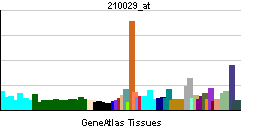Indoleamine 2,3-dioxygenase
| Indoleamine-pyrrole 2,3 dioxygenase | |||||||||||||
|---|---|---|---|---|---|---|---|---|---|---|---|---|---|
 PDB rendering based on 2d0t. | |||||||||||||
| |||||||||||||
| Identifiers | |||||||||||||
| Symbols | INDO ; CD107B; IDO | ||||||||||||
| External IDs | Template:OMIM5 Template:MGI HomoloGene: 48082 | ||||||||||||
| EC number | 1.13.11.42 | ||||||||||||
| |||||||||||||
| RNA expression pattern | |||||||||||||
 | |||||||||||||
| More reference expression data | |||||||||||||
| Orthologs | |||||||||||||
| Template:GNF Ortholog box | |||||||||||||
| Species | Human | Mouse | |||||||||||
| Entrez | n/a | n/a | |||||||||||
| Ensembl | n/a | n/a | |||||||||||
| UniProt | n/a | n/a | |||||||||||
| RefSeq (mRNA) | n/a | n/a | |||||||||||
| RefSeq (protein) | n/a | n/a | |||||||||||
| Location (UCSC) | n/a | n/a | |||||||||||
| PubMed search | n/a | n/a | |||||||||||
Indoleamine-pyrrole 2,3-dioxygenase (IDO or INDO EC 1.13.11.42) is an immunomodulatory enzyme secreted by some alternatively activated macrophages and other immunoregulatory cells (also used as an immune subversion strategy by many tumors).
Gamma-interferon (IFNG; MIM 147570) has an antiproliferative effect on many tumor cells and inhibits intracellular pathogens such as Toxoplasma and Chlamydia, at least partly because of the induction of indoleamine 2,3-dioxygenase (INDO; EC 1.13.11.42). This enzyme catalyzes the degradation of the essential amino acid L-tryptophan to N-formylkynurenine.[supplied by OMIM][1]
IDO is the first and rate limiting enzyme of Tryptophan catabolism through Kynurenine pathway, thus causing depletion of tryptophan which can cause halted growth of microbes as well as T cells.
It catalyzes conversion of L-tryptophan to N-formylkynurenine.
References
Further reading
- Grohmann U, Fallarino F, Puccetti P (2004). "Tolerance, DCs and tryptophan: much ado about IDO". Trends Immunol. 24 (5): 242–8. PMID 12738417.
- Takikawa O (2005). "Biochemical and medical aspects of the indoleamine 2,3-dioxygenase-initiated L-tryptophan metabolism". Biochem. Biophys. Res. Commun. 338 (1): 12–9. doi:10.1016/j.bbrc.2005.09.032. PMID 16176799.
- Puccetti P (2007). "On watching the watchers: IDO and type I/II IFN". Eur. J. Immunol. 37 (4): 876–9. doi:10.1002/eji.200737184. PMID 17393386.
- Kadoya A, Tone S, Maeda H; et al. (1992). "Gene structure of human indoleamine 2,3-dioxygenase". Biochem. Biophys. Res. Commun. 189 (1): 530–6. PMID 1449503.
- Kamimura S, Eguchi K, Yonezawa M, Sekiba K (1991). "Localization and developmental change of indoleamine 2,3-dioxygenase activity in the human placenta". Acta Med. Okayama. 45 (3): 135–9. PMID 1716396.
- Dai W, Gupta SL (1990). "Molecular cloning, sequencing and expression of human interferon-gamma-inducible indoleamine 2,3-dioxygenase cDNA". Biochem. Biophys. Res. Commun. 168 (1): 1–8. PMID 2109605.
- Tone S, Takikawa O, Habara-Ohkubo A; et al. (1990). "Primary structure of human indoleamine 2,3-dioxygenase deduced from the nucleotide sequence of its cDNA". Nucleic Acids Res. 18 (2): 367. PMID 2326172.
- Werner-Felmayer G, Werner ER, Fuchs D; et al. (1990). "Tumour necrosis factor-alpha and lipopolysaccharide enhance interferon-induced tryptophan degradation and pteridine synthesis in human cells". Biol. Chem. Hoppe-Seyler. 370 (9): 1063–9. PMID 2482041.
- Carlin JM, Borden EC, Byrne GI (1989). "Interferon-induced indoleamine 2,3-dioxygenase activity inhibits Chlamydia psittaci replication in human macrophages". J. Interferon Res. 9 (3): 329–37. PMID 2501398.
- Kobayashi K, Hayashi K, Sono M (1989). "Effects of tryptophan and pH on the kinetics of superoxide radical binding to indoleamine 2,3-dioxygenase studied by pulse radiolysis". J. Biol. Chem. 264 (26): 15280–3. PMID 2549057.
- Daley-Yates PT, Powell AP, Smith LL (1989). "Pulmonary indoleamine 2,3-dioxygenase activity and its significance in the response of rats, mice, and rabbits to oxidative stress". Toxicol. Appl. Pharmacol. 96 (2): 222–32. PMID 2848333.
- Najfeld V, Menninger J, Muhleman D; et al. (1993). "Localization of indoleamine 2,3-dioxygenase gene (INDO) to chromosome 8p12-->p11 by fluorescent in situ hybridization". Cytogenet. Cell Genet. 64 (3–4): 231–2. PMID 8404046.
- Burkin DJ, Kimbro KS, Barr BL; et al. (1993). "Localization of the human indoleamine 2,3-dioxygenase (IDO) gene to the pericentromeric region of human chromosome 8". Genomics. 17 (1): 262–3. PMID 8406467.
- Malina HZ, Martin XD (1996). "Indoleamine 2,3-dioxygenase: antioxidant enzyme in the human eye". Graefes Arch. Clin. Exp. Ophthalmol. 234 (7): 457–62. PMID 8817290.
- Munn DH, Zhou M, Attwood JT; et al. (1998). "Prevention of allogeneic fetal rejection by tryptophan catabolism". Science. 281 (5380): 1191–3. PMID 9712583.
- Takikawa O, Littlejohn TK, Truscott RJ (2001). "Indoleamine 2,3-dioxygenase in the human lens, the first enzyme in the synthesis of UV filters". Exp. Eye Res. 72 (3): 271–7. doi:10.1006/exer.2000.0951. PMID 11180976.
- Kudo Y, Boyd CA (2001). "The role of L-tryptophan transport in L-tryptophan degradation by indoleamine 2,3-dioxygenase in human placental explants". J. Physiol. (Lond.). 531 (Pt 2): 417–23. PMID 11230514.
- Terentis AC, Thomas SR, Takikawa O; et al. (2002). "The heme environment of recombinant human indoleamine 2,3-dioxygenase. Structural properties and substrate-ligand interactions". J. Biol. Chem. 277 (18): 15788–94. doi:10.1074/jbc.M200457200. PMID 11867636.
- Kvirkvelia N, Vojnovic I, Warner TD; et al. (2002). "Placentally derived prostaglandin E2 acts via the EP4 receptor to inhibit IL-2-dependent proliferation of CTLL-2 T cells". Clin. Exp. Immunol. 127 (2): 263–9. PMID 11876748.
- Sedlmayr P, Blaschitz A, Wintersteiger R; et al. (2002). "Localization of indoleamine 2,3-dioxygenase in human female reproductive organs and the placenta". Mol. Hum. Reprod. 8 (4): 385–91. PMID 11912287.
External links
- Indoleamine-Pyrrole+2,3,-Dioxygenase at the US National Library of Medicine Medical Subject Headings (MeSH)
| This immunology article is a stub. You can help Wikipedia by expanding it. |